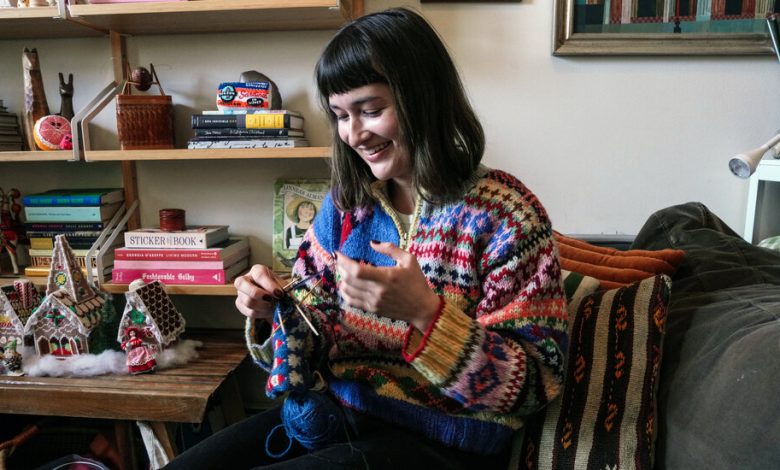The Emotional Gamble of a Hand-Knitted Gift

Cydney Alvarez, a fabric developer in Brooklyn, was packing to visit her family in Dallas for Christmas last year when she realized she had knitted her stepmother two left-handed mittens. She rushed to replace one: “I was frantically trying to finish it on the flight,” she said.
But the challenge is part of why Ms. Alvarez, 29, likes to knit presents. Since 2020, she has knitted about a dozen gifts for her family each year for the holidays. This year, she made five pairs of mittens, four hats, a stuffed fox wearing a reindeer-patterned dress, and a sweater for her father’s large French bulldog. “I’m a little nervous it won’t fit him,” she said of the dog sweater, her first. “But I’m hoping for the best.”
The coronavirus pandemic fueled a knitting boom, with people craving new hobbies or looking to quell their nerves during lockdown. And at this time of year, knitting lends itself well to gift-giving. After all, there are only so many beanies one can make for a personal collection.
But when it comes to hand-knitted presents, some New Yorkers are dealing with all kinds of anxieties and expectations over each item’s fit, style, pattern and color choice. Will the recipient appreciate the time and thought that went into the project? Or simply stuff the new scarf or cowl in a drawer and never pull it out? For many knitters, deciding who receives a present hinges on these questions.
And then there’s the curse of the “boyfriend sweater” — the looming superstition that if you knit your partner a sweater, they will inevitably break up with you.
“You have to really think about the people you’re giving gifts to,” said Joelle Hoverson, the founder of Purl Soho knit shop and author of “Last-Minute Knitted Gifts.” “Because it is so loaded.”
Maya Gooding, 31, has knitted her father a hat every Christmas for the past six years. As crafters would say, Ms. Gooding’s father is “knit-worthy.”
“He’s always wearing those hats,” said Ms. Gooding, a knitwear designer in Westchester who works in the Flatiron district. “My mom will call me: ‘How am I supposed to wash his hat? He’s wearing it all the time.’ When I hear that, no matter the cost or time, I’ll make him a hat if he wants.”
For Julie Robinson, 34, someone she has cried in front of is usually knit-worthy. “We need to have a close relationship,” she said.
Ms. Robinson, a knitwear teacher and designer in Ridgewood, Queens, typically knits other people small accessories that can be finished quickly. She has knitted only one sweater, for her mother, when she was in high school in the early 2000s. It was tube-shaped with short sleeves and a ribbon around the neck. Ms. Robinson chose a yarn that was red — her mother’s favorite color.
“She never wore that sweater,” Ms. Robinson said. “I would venture a guess that it is still somewhere in their house, probably because she feels bad about never wearing it, but it’s so not her style.”
Fortunately, Ms. Robinson prefers to let go of her gifts once she’s given them. “I’m very much aligned with Marie Kondo on this,” she said.
A skein of yarn can cost anywhere from a couple of dollars to $30, and it might take two or three to make a scarf long enough to loop around an adult’s neck several times on the coldest days. Ms. Gooding, the knitwear designer, estimated that the cost of hand-knitting a sweater — including tools, yarn and fair pay for hourly labor — could reach $2,000. For even the most seasoned knitters, a project might take weeks. The fastest Ms. Robinson has ever knitted a sweater was within one week.
“And that’s with some pretty big needles and thick yarn,” she said.
Several yarn companies, such as Lion Brand and We are Knitters, have reported major spikes in sales amid the pandemic-era boom. Celebrities like the Olympic diver Tom Daley, who recently knitted a cardigan for Gillian Anderson’s character to wear on “Sex Education,” have picked up needles. In New York City, knitting circles have cropped up at bars, parks and coffee shops. The trend also coincides with a broader desire for eco-friendly clothes made of natural fibers.
“The world of fashion is turning towards garments that are more politically correct in their origins,” said Olivia Eaton, an adjunct associate professor at Pratt Institute who teaches hand-knitting. “Wool from a sheep is one of the most sustainable, I think, materials that you can use.”
That can make knitters feel even better about sharing their craft with others. But it can still sting if the gift doesn’t seem to be appreciated.
Lynda Villa-Fournier, 54, a health care worker and longtime knitter in the Bronx, recalled a gift she made for a friend.
“I knit something for her baby, and I never got a picture of the baby wearing it. Nothing,” she said. “So, I never knit anything for her baby again.”
Ms. Eaton, echoed this sentiment. “Honestly, I’m more ready to make something for somebody if I absolutely know they’re going to wear it,” she said.
However, Ms. Eaton believes hand-knitted presents should be donated or passed along as hand-me-downs if the original recipient isn’t thrilled with the gift. Years ago, Ms. Eaton was waiting at a subway station in Brooklyn when she noticed a young woman wearing a colorful granny-square vest with a hood. Ms. Eaton recognized the garment. She had crocheted it for a friend, who, it turned out, had given it to her roommate.
“I actually appreciate the fact that most of my friends are ruthless in not being sentimental,” she said.
Austin Rivers, 29, started off making only gifts after he learned to knit in 2018. An initial project included eight sets of fingerless gloves for his castmates during a musical theater performance tour in Japan.
In 2020, Mr. Rivers started Knit the Rainbow, a New York nonprofit organization that collects and distributes hand-knitted garments to homeless L.G.B.T.Q.+ youth. For any knitter worried about choosing the correct size or colorway, donating to an unknown recipient can be a way to alleviate that stress.
“You can make a size 5 sock or a size 12 sock,” Mr. Rivers said. “And we’ll be able to find someone who needs that.”
Some people find it less anxiety-inducing to knit for children — or better yet, babies who can’t yet talk and say they don’t like their new blankets.
Amy Reeder, 43, and her fiancée, Kate Zimmermann, 39, live in Manhattan and have both knitted gifts for children and babies over the years. There was a Cookie Monster cardigan with cookie buttons, a watermelon hat, and a turtle beret and shark balaclava for Ms. Reeder’s nieces and nephews.
“I feel like for both of us in different ways, it’s a creative exercise,” Ms. Zimmermann, a book editor, said. “It’s a body of work — sometimes hilarious, kind of weird.”
But for Ms. Alvarez, the fabric developer, knitting for children can be nerve-racking. They’re often more honest than adults, she said. Last year, she made her 3-year-old niece a stuffed alpaca. “And as I was wrapping it,” she said, “I was thinking, ‘What if she thinks it’s scary or she doesn’t like it?’”
Luckily, her niece loved it.
“I was so relieved,” Ms. Alvarez said.





